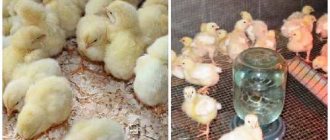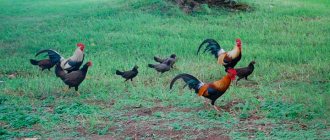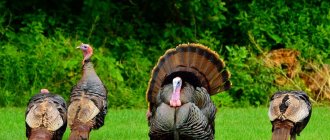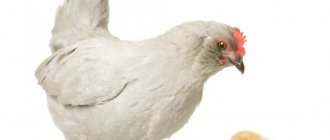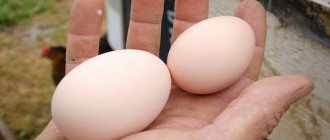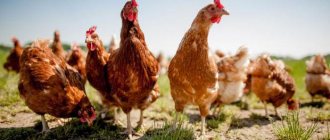Home » Articles about chickens » How many eggs to lay under a hen
Artificial incubation allows you to get tens and hundreds of chicks, but this method has a significant drawback - in the absence of backup power, you can suffer serious losses in the event of a power outage. Natural incubation does not require additional costs, but has restrictions on the season and the size of the brood. How many eggs can be placed under a hen, at what period does the hen's instinct to incubate awaken - knowing the answers to these questions, you will be able to get healthy and strong chickens without spending money on an incubator.
Signs of a good hen
If a hen clucks and lingers in the nest, this indicates the awakening of the brooding instinct, but it does not mean that she is completely subject to it - the bird may well lose interest in laying eggs. To make sure that she is ready for breeding, more than 3 pieces of decoys are placed under her. If the hen leaves the clutch only for feeding time, and when people approach, she strives to protect her (puffs up her feathers, clucks quietly), then the decoys should be replaced with real eggs.
If a potential hen does not live up to expectations, then you can find a replacement for her among individuals who previously hatched offspring and have stopped laying eggs. The bird is placed in a nest located in a shaded place, decoys are placed under it, and covered with a basket or box. They release it only for feeding twice a day. Under such conditions, the chicken's instinct usually awakens within 4-5 days. If this does not happen, then there is no point in continuing the experiment.
The chicken must be absolutely healthy - the presence of any diseases and ectoparasites (mites, etc.) is not allowed.
If a bird is going to hatch chicks during an unfavorable period (autumn, winter), then it is kicked out of the nest and access there is blocked (you can temporarily place it in a cage). Some farmers instead place a bottle of ice water under the hen or wet her legs and chest. This usually neutralizes the brooding instinct.
Features of different breeds of chickens
Some breeds of chickens were selected specifically for laying a large number of eggs - the so-called egg breeds. They are capable of producing up to 200 eggs per year or more, but in hens the brooding instinct is poorly developed.
Among the breeds popular in the CIS countries, several can be noted (including those prone to brooding):
Welzumer is the most popular species in small farms and farms. It is considered a mixed meat-egg breed, as it annually brings owners up to 180-190 large (60-65 g) eggs. Disadvantages: some hens have lost their brooding instinct, so you will have to select chickweeds in advance;
Breed Welsumer
Cochin is one of the largest and most flexible breeds. Decent egg production in the winter months, easy to find laying hens;
Brahma is a breed that is distinguished by its large size and weight. But birds grow rather slowly and are prone to obesity. Dark brams are considered good cows;
Brahma breed
Kuchinsky Jubilee is one of the most unpretentious and calm breeds popular in Russia. Egg production is also high, and most hens cope well with the functions of hens. After hatching, you can immediately determine the sex of the chick: roosters have lighter wings than the carcass, while hens have darker wings. Thanks to the large amount of fluff, the hen calmly hatches up to 14-15 eggs.
Kuchin anniversary
Socket device
The bird hatches its clutches in shaded, quiet places at a distance from other individuals. The area of the nest should be sufficient to freely accommodate the hen with its clutch. Optimal size: 55 cm×35 cm - it is most convenient to use a box made of wood or plastic. The bottom is lined in layers. At the bottom there is turf, the next layers are straw (8-10 cm) and fluff. You can provide a free canopy that does not interfere with leaving the box and returning back. The air temperature must be at least +10°C.
To avoid attacks by rats, nests are located above floor level.
Creating the necessary conditions for hatching chickens
A nest in a darkened corner of the poultry house or a separate room in which the hen willingly laid eggs is also suitable for breeding. But the hen also needs peace; overly curious neighbors can harm future chickens and make the hen nervous and behave aggressively:
- A box or cardboard box measuring at least 60 cm in length and 30-50 cm in width, with high sides to prevent eggs from accidentally rolling out.
- The bottom is covered with turf, leaves or straw.
- It is worth pouring sawdust or fresh hay on top.
- The hen herself lines the bottom with down and feathers.
- The room should be cool, dry, but not cold.
- Chickens must be provided with good ventilation and constant access to fresh air. If desired, the hen should calmly leave the nest and return freely.
A properly equipped place for breeding chickens in many ways becomes the key to successful breeding of offspring.
Egg selection
Chickens are capable of laying eggs without fertilization, but offspring can only be obtained from fertilized eggs - the correct ratio of chickens to roosters must be maintained (1 rooster per 10-12 individuals). The optimal age of laying hens is 7 months. To understand which eggs can be placed under the hen and which are not suitable, they are selected according to external criteria and examined using an ovoscope.
Hatching eggs can be stored for 5-6 days at a temperature of +15...+20°C. It is advisable to turn them over periodically during storage to prevent the embryo from sticking to the wall.
External criteria
Eggs should be of medium size - large ones most often have two yolks, very small ones have an underdeveloped embryo. Chipped specimens, as well as those with calcareous growths or irregular shapes, are excluded.
Ovoscopy
Inspection using an ovoscope allows you to identify defects:
- displacement of the air chamber and its large size (over 4 mm);
- mobility or too large yolk size;
- double yolk;
- blood stains, protein turbidity;
- microcracks invisible to the eye.
Basic rules for raising turkeys
The first rule of keeping turkeys is to keep turkeys separate from the main flock of other poultry. It often happens that chickens and many waterfowl are hidden carriers of pathogenic microorganisms, and they themselves may not get sick, but for turkeys these infections can be dangerous.
Therefore, it is advisable to allocate an area for keeping turkeys in the corner opposite the chicken coop.
Another indisputable rule is to purchase chicks for further breeding only from trusted sellers or poultry farms. In this case, there is a guarantee of getting healthy young animals that will grow and develop without any problems.
Another guaranteed way to obtain healthy birds for further rearing is to purchase eggs for incubation and hatch them at home in an incubator. In this case, the chicks will hatch healthy and grow without disease. Only then will almost all of the young survive.
The third rule of raising turkey poults is to adhere to a certain diet for turkey poults from birth to three months of age. Turkey poults are raised for meat until they are about six months old. Moreover, the young animals begin to gain most of their weight three months after birth.
But in the first 60 days after birth, turkey poults do not grow very slowly. This is a physiological feature of these birds. Therefore, you should not experiment with nutrition during this period. Do not introduce any eggs, cottage cheese, grass, vitamins or medicines. It is enough to feed turkey poults with starter feed from the first days of life. By the way, also put a drinking bowl with clean water.
Optimal quantity
When the chicken, which has a brooding instinct, has passed the test, material tested by an ovoscope is placed under it. How many eggs can be placed under a hen depends on the breed (size) - standard numbers are 12-15 pieces. Miniature chickens can place 10-12 pieces under them, large ones - 15-17 pieces. Chickens can also hatch eggs:
- turkeys – 7-11 pcs.;
- ducks – 7-11 pcs.;
- geese – 5-7 pcs.
It is better to put an even number - it is believed that in this case the hatching of young animals will be better. The hen is placed on the clutch in the evening - this reduces stress levels and allows the bird to get used to it faster.
3 days before this, the chicken is examined for the presence of parasites, and if necessary, treatment is carried out. She is also provided with balanced food.
You cannot add new specimens during the incubation process - after the chicks from the main batch appear, the hen will leave the nest.
When to apply?
Before you think about how to place eggs under a hen, you need to figure out when is the best time to do this. Incorrect timing may cause the hatched offspring to die due to cold weather.
The optimal time is the first half of April. In this case, the chickens will hatch after 3 weeks, that is, in early May, and will have time to get stronger by autumn and develop good plumage by winter.
Important! Since the climate varies from region to region, please be aware of the weather conditions. Check the forecast and ensure that after the expected birth of the chicks there will be no prolonged cold, and especially frost.
Control of the incubation process
The hen is not disturbed for the first and last 2-3 days - if you ignore this rule, she may leave the nest as a result of stress. On average, the incubation process takes 3 weeks; during this period, the bird should leave only for feeding, bathing and walking (maximum time - 20 minutes). While the bird is absent, the clutch is inspected for damage. Crushed specimens are removed. The litter is changed as it gets dirty. The bird is regularly checked for the presence of parasites - this allows timely action to be taken.
If the hen does not leave the nest for feeding and bathing, she is forcibly removed from the clutch. Access to it is temporarily blocked so that the bird does not return without eating.
The feeder and drinking bowl should be located close to the hen.
When the chicken is away, it is important to keep the eggs warm by covering them. If the bird is absent for more than 20 minutes, it is returned to the nest.
How an egg is born and laid
The yolk is formed in the ovary, and is overgrown with protein and shell in the oviduct. Stages:
- In the first half of the day, the yolk comes out into the funnel of the oviduct.
- The yolk remains in the funnel for about 20 minutes and passes into the “protein” section of the reproductive system, in which protein is formed over the course of 3 hours.
- After moving to the isthmus, the future embryo becomes overgrown with the subshell membrane within 1 hour.
- The shell takes approximately 16 hours to form in the uterus.
Related publications
Pets: proper dog care
Aug 22, 2020
Methods for transporting pets
Aug 5, 2020
The process takes about 1 day. If you follow the feeding regime, light and heat, the hen will lay eggs in a timely manner.
Control of embryonic development
Over the course of 21 days, an ovoscope check is carried out 3 times. The first time the procedure is performed on the 7th day after the start of incubation, then it is repeated on the 11th day. Final control is carried out on the 18th day.
During the first check, unfertilized specimens are identified (they are completely light), a dead or poorly developed embryo (the embryo is visible near the shell or dark annular vessels are clearly visible).
At the second stage, you can see blood vessels on a light background, the shadow of the embryo is 1/4 part. At the final stage, the embryo is visible as a dark spot, and its movements can be seen near the blunt end.
If defects are detected, rejected eggs are removed, and the remaining ones are moved closer to the center of the nest. New copies are not added.
Condition assessment
During incubation, the eggs are inspected three times. Larger quantities are not recommended, as there is a risk of shell damage. It also negatively affects the emotional state of the hen and the embryo.
- The embryo is not yet visible, but blood vessels are already visible. If the chick has died, they become dark.
- Blood vessels envelop the light spot in the center. If the formation of the embryo does not proceed according to schedule, then the vessels do not completely cover the lateral space. The dead embryo, which is visible at this stage, looks like a small dark spot without blood vessels.
- The embryo is clearly visible upon examination: the outline of a neck is visible at the blunt end.
After each candling, rejected specimens are destroyed.
Hatching of young animals
Pecking of chickens is observed in the period from 19 to 21 days. The first young that appear are left with the hen until completely dry, and then transplanted into a brooder (optimum temperature for chickens: +26...28°C). If this is not done, then after 24-36 hours the hen will leave the nest, taking the hatched young, and the remaining eggs will remain without heat. Only after the entire brood has emerged are the chicks returned.
You can add chicks from other laying hens to the brood, but their total number should not exceed 25.
A good hen can hatch another batch of chicks if, after the first brood appears, hatching eggs are placed under her. It is important to understand that incubation is a grueling process and leads to exhaustion of the bird. During this period, she loses weight and stops laying eggs.
Chicken landing
It is not difficult to plant a chicken on eggs at home; all you need to do is follow a few simple steps. First of all, it is important to properly organize the nest. It should be in a fairly quiet place, the bird should be comfortable in it. But at the same time, it should not be too spacious so that the eggs do not roll out during incubation. The ideal size is 55 by 35 cm.
To do this, you can use a wooden box in which straw is placed. In the future, the chicken will create comfortable conditions for brooding and insulate the area with down and feathers. It is best to cover the exit with something light so that the chicken can leave and enter the nest at any time. Then they put in the decoys - it is necessary for the chicken to get used to incubation. After a few days, the decoys are replaced with real eggs.
It is important to know that if there are several hens in one chicken coop, they should be seated as far apart as possible. This should be done in order to eliminate confusion among the birds, which could lead to possible fights. After the hen is placed, she will be able to clean up the nest herself; the poultry farmer will only need to periodically monitor it while the hen is feeding.
Selection and placement of eggs
The selected bird is taken to the nest, and if everything goes well, it begins to hatch the eggs. One of the most important points in raising chickens is the correct placement of eggs. It is important to know which ones to choose for incubation. Only fresh eggs, laid no earlier than six days before laying, are suitable; they should not be broken or dirty. It is better to take medium-sized specimens, because small ones often have an inferior embryo, while large ones can contain two embryos.
It is important to correctly determine the required number of eggs to lay - it directly depends on the build of a particular bird. The quantity must be selected in such a way that the chicken covers them all, provided that they are located in one layer. If the chicken is large enough, then add 13 to 15 pieces.
During the hatching period, you cannot add more eggs, because after the first chicks appear, the hen will leave the nest. It is worth paying attention to the fact that the chicken copes very well with hatching eggs and other birds.
Oviposition
Chickens, compared to other bird species, have the longest egg-laying period. If you feed the laying hen well and provide her with proper care, she will be able to lay eggs for 365 days .
After this, she will need to rest for 30 days. And then the cycle will begin again.
In the first year of a hen's life, she has maximum egg production. Every year the number of eggs laid decreases. The hen produces the minimum amount by the 10th year of her life. A hen can become a laying hen already in the first year of life, but her maternal instincts are fully manifested until 2 or 4 years of age .
Advantages and disadvantages of breeding chickens with whooping hens
Hatching eggs by a brood hen is an ideal way to raise poultry. Main advantages:
- The owner does not need to supervise the process, turn the eggs, or control the temperature.
- Kvochka, a hen who likes to incubate eggs, will take care of the chickens herself. She will teach the chicks to drink, eat, and protect them from threats and bad weather.
- Instinct will tell the hen how to keep her babies warm. She will help them hatch, break the shell if necessary.
- The hen will roll out the non-viable eggs from the nest.
- There is no need to spend money on buying an incubator.
Hen and chicks
Pay attention! When sitting in the nest, at first the hen does not distinguish lifeless eggs from those in which embryos develop. It sits on everything and does not allow other chickens to approach its favorite place.
There are reasons why owners breed birds in an incubator:
- A quonka can sit on one and a half dozen eggs, no more, so that all are covered with feathers. A larger quantity can be placed in the incubator.
- The eggs are collected in advance, and the hen must be placed in the nest at the same time.
- Sometimes quons inadvertently crush eggs and chicks.
- The future brood needs to have a separate walking area fenced off, as the hens become belligerent towards anyone who approaches.
Considering the pros and cons of raising chicks naturally, it becomes clear that it is easier for the owner of a small chicken coop to use a hen to hatch chicks. On large farms, it is more convenient to breed poultry in an incubator.
